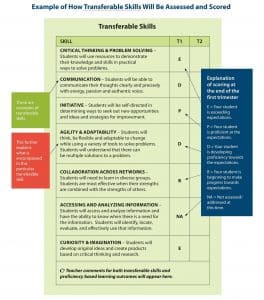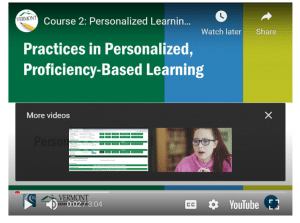A Cornucopia of Competency-Based Education Resources from Vermont
CompetencyWorks Blog
The Vermont Agency of Education offers outstanding resources for educators and leaders at all levels who are advancing competency-based education. They have taken many complex topics and explained them in clear language with links to essential resources and examples of current practice.
At the Aurora Institute, we often receive requests for basic and advanced information about competency-based education to guide policy, practice, and professional learning. Clicking through the Vermont AOE’s Personalized Learning and Proficiency-Based Learning pages is one great place to find it. (They use the term “proficiency-based” rather than “competency-based” but are referring to the same sets of principles and practices.)
Crucially, the AOE has teams of staff who are dedicated to supporting school and district implementation of competency-based education. (Also crucially, the teams include experienced K-12 educators.) They are actively advancing Vermont policies that enable aspects of competency-based learning statewide. For example, Vermont’s Education Quality Standards say that:
“Schools may or may not use credits for the purposes of demonstrating that a student has met the graduation requirements. When used, credits must specify the proficiencies demonstrated in order to attain a credit and shall not be based on time spent in learning. Further, students may receive credit for learning that takes place outside of the school, the school day, or the classroom.”
The AOE website starts with the basics, such as What Is Personalized Learning?, which includes definitions and five essential attributes of personalized learning environments:
- Personal relationships with mutual respect and every student feeling connected to and well-known by at least one trusted adult;
- Flexible pathways to high school completion and postsecondary readiness that include options such as dual enrollment, blended learning, career and techical education, and a variety of out-of-school learning opportunities;
- Personalized learning plans (PLPs, or learner profiles) that are developed collaboratively and document students’ individual strengths, needs, motivations, goals, and progress;
- Proficiency-based progression aligned to the state’s standards and focused on transferable skills, with clear standards, tiered supports, and progress based on demonstrating mastery; and
- Student agency in which students collaborate with teachers to co-design and take ownership over their learning process.
Going beyond the basics, many resources support deeper understanding and practice. The Personalized Learning Planning Process page includes an extensive PLPs Manual, explanations of PLPs from both adult and student perspectives, and a glossary of terms. Six case studies illustrates how PLPs, IEPs, and proficiency-based graduation requirements work together. The page ends with a series of self-paced courses on key practices such as flexible pathways, student agency, portfolios, and student-designed learning projects.
Pat Fitzsimmons, the leader of the state’s proficiency-based learning team, kindly sent me two new Vermont AOE resources recently. The first is Essential Components for Ensuring Local Comprehensive Assessment Systems Are Culturally Relevant and Equitable. It provides extensive materials that align with and advance the state’s theory of action:
“If each supervisory union/school district implements a local comprehensive assessment system with a balance of assessment types that provides information about student proficiency in a variety of ways, clearly communicates performance criteria, and identifies methods for communicating student progress, then Vermont’s SUs/SDs will enhance the effectiveness, availability, and equity of services provided to all students.”
One of the many useful resources is the Equity Lens Tool, a protocol for evaluating equity of opportunities and outcomes when making decisions. A partial list of the questions the tool provides to inform policy and practice decisions includes:
- Who are the groups affected by this policy, program, practice, or decision? What are the potential impacts on this group or groups?
- What assumptions and/or biases regarding the stakeholders/communities/students/groups affected by this policy, program, practice, or decision have you surfaced/considered?
- Does this policy, program, practice, or decision have the potential to create, ignore or worsen existing equity gaps or produce other unintended consequences? If yes, how?
- What are the barriers to more equitable outcomes that you have identified and how can they be mitigated and/or eliminated?
- In using this protocol, what questions were raised and remain unresolved?
The second document Fitzsimmons shared is Vermont Proficiency-Based Grading Practices. It provides examples of current grading and reporting practices that help innovative schools and districts support each other’s success. It offers explanations that can help staff and families understand unfamiliar practices, such as the following:
“Rather than saying, ‘Dylan got a 68 on his biology test on plant and animal cells,’ a proficiency grade lets Dylan and his parents know that ‘Dylan is proficient in using evidence to back up claims, and he is approaching proficiency in his understanding of how plant and animal cells function.’ Armed with this information, Dylan’s learning can be personalized, and instruction focused on where he needs to improve. His teacher can also use this information to refine and differentiate learning experiences in order to help Dylan reach proficiency. The focus is on the learning. The grading system provides feedback regarding where a student is along a continuum of learning.”
Links to materials from schools and districts that have moved deeply into implementation can greatly accelerate the work of others. The first image below, from the Hartford, Vermont school district, provides families with a terrific introduction to personalized, proficiency-based learning. The subsequent image is from Hartford’s Understanding Your Child’s Report Card (and the rest of the four-pager is really worth seeing too). These are just two of the many valuable examples provided in the Vermont Proficiency-Based Grading Practices document.


If you’re working to advance competency-based education practice at the school, district, or state level, spending some time with the Vermont AOE’s cornucopia of online materials is sure to provide valuable ideas and strategies.
Learn More
- Strengthening Local Assessment Systems for Personalized, Proficiency-Based Education: Strategies and Tools for Professional Learning
- Student-Designed Performance Assessments for Personalized Learning and Student Agency
- Structuring Standards-Based Instruction and Assessment at Vancouver iTech
Eliot Levine is the Aurora Institute’s Research Director and leads CompetencyWorks.
